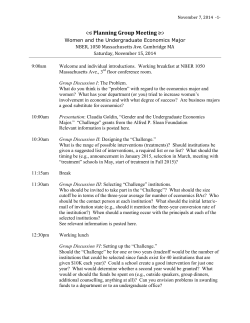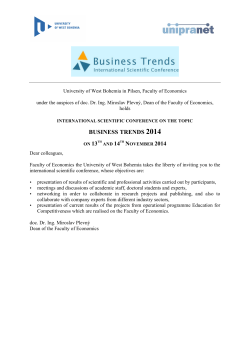
Chapter 17 Economic Analysis in the Public Sector
Chapter 17 Economic Analysis in the Public Sector • Framework of BenefitCost Analysis • Valuation of Benefits and Costs • Benefit-Cost Ratios • Analysis of Public Projects Based on Cost-Effectiveness (c) 2001 Contemporary Engineering Economics 1 Benefit-Cost Analysis • • • Benefit-cost analysis is commonly used to evaluate public projects. Benefits of a nonmonetary nature can be quantified and factored into the analysis. A broad range of project users distinct from the sponsor should be considered—benefits and disbenefits to all these users can (and should) be taken into account, (c) 2001 Contemporary Engineering Economics 2 Framework of Benefit-Cost Analysis 1) Identifying all the users and sponsors of the project. 2) Identifying all the benefits and disbenefits of the project. 3) Quantifying all benefits and disbenefits in dollars or some other unit of measure. 4) Selecting an appropriate interest rate at which to discount benefits and costs to a present value. (c) 2001 Contemporary Engineering Economics 3 Benefit-Cost Ratio Criterion Equivalent Users' Net Benefits Benefit - Cost Ratio = Equivalent Sponsor' s Net Cost If this BC ratio exceeds 1, the project can be justified (c) 2001 Contemporary Engineering Economics 4 Definition of Benefit-Cost Ratio N B bn (1 i ) n n0 N C cn (1 i ) n n0 Bn=Benefit at the end of period n, bn 0 cn=Expense at the end of period n, cn 0 An= bn – cn N = Project life i =Sponsor’s interest rate (discount rate) (c) 2001 Contemporary Engineering Economics 5 K I cn (1 i ) n Equivalent capital investment n0 C' N c (1 i) n n Equivalent O&M costs n K 1 B B BC(i ) , I C' 0 C I C' (c) 2001 Contemporary Engineering Economics 6 Example 17.1 BC Analysis (c) 2001 Contemporary Engineering Economics 7 B = $20( P / F, 10%, 2) + $30( P / F, 1%, 3) +$30( P / F, 10%, 4) + $20( P / F, 10%, 5) = $71.98 C = $10 + $10( P / F, 10%, 1) + $5( P / F, 10%, 2) + $5( P / F, 10%, 3) + $8( P / F, 10%, 4) + $8( P / F, 10%, 5) = $37.41 I = $10 + $10( P / F, 10%, 1) = $19.09 C’ = C – I = $18.3 71.98 BC(10%) 1.92 1, Accept the project. $19.09 $18.32 (c) 2001 Contemporary Engineering Economics 8 Relationship between B/C Ratio and NPW B 1 I C' B > (I + C’) B – (I+ C’) > 0 PW(i) = B – C > 0 (c) 2001 Contemporary Engineering Economics 9 Incremental Analysis Based on BC(i) B Bk Bj I I k I J C' C' k C' j BC (i ) k j B I C ' (c) 2001 Contemporary Engineering Economics 10 Example 17.2 Incremental Benefit-Cost Ratios A1 A2 A3 I $5,000 $20,000 $14,000 B 12,000 35,000 21,000 C’ 4,000 8,000 1,000 PW(i) $3,000 $7,000 $6,000 (c) 2001 Contemporary Engineering Economics 11 Solution A1 A2 A3 BC(i) 1.33 1.25 1.40 Ranking Base A1 A3 A2 I +C’ $9,000 $15,000 $28,000 $21,000 $12,000 BC(i)2 1 ($14,000 $5,000) ($1,000 $4,000) 1.5 1, select A2. $35,000 $21,000 BC(i)2 3 ($20,000 $14,000) ($8,000 $1,000) 1.08 1, select A2. (c) 2001 Contemporary Engineering Economics 12 General Procedure for Cost-Effectiveness Studies • Step 1: Establish the goals to be achieved by the analysis. • Step 2: Identify the imposed restrictions on achieving the goals, such as budget or weight. • Step 3: Identify all the feasible alternatives to achieve the goals. • Step 4: Identify the social interest rate to use in the analysis. • Step 5: Determine the equivalent life-cycle cost of each alternative, including research and development, testing, capital investment, annual operating and maintenance costs, and salvage value. (c) 2001 Contemporary Engineering Economics 13 • Step 6: Determine the basis for developing the costeffectiveness index. Two approaches may be used; – (1) the fixed-cost approach and – (2) the fixed-effectiveness approach. – If the fixed-cost approach is used, determine the amount of effectiveness obtained at a given cost. – If the fixed-effectiveness approach is used, determine the cost to obtain the predetermined level of effectiveness. • Step 7: Compute the cost-effectiveness ratio for each alternative based on the selected criterion in Step 6. • Step 8: Select the alternative with the maximum costeffective index. (c) 2001 Contemporary Engineering Economics 14 Cost-Effectiveness Decision Criterion • Fixed Cost Approach • Fixed Effectiveness Approach Maximize Effectiveness Minimize Cost Subject to: Subject to: Budget Constraint Must meet the minimum effectiveness (c) 2001 Contemporary Engineering Economics 15 Case Study - Selecting an Weapon System (c) 2001 Contemporary Engineering Economics 16 Weapon System Alternatives Alternative Aj Advantage Disadvantage Accuracy, target recognition Probability of Kill A1: Inertial navigation system Low cost, mature technology. A2: Inertial navigation system: Global positioning system Moderate cost, nature Target recognition technology 0.70 A3: Imaging infrared (I2R) Accurate, target recognition High cost, bunkered target detection 0.90 A4: Synthetic aperture radar Accurate, target recognition High cost 0.99 A5: Laser detection/ranging Accurate, target recognition High cost, technical maturity 0.99 A6: Millimeter wave (MMW) Moderate cost, accurate Target recognition 0.80 (c) 2001 Contemporary Engineering Economics 0.33 17 Life-Cycle Costs for Weapon Development Alternative Expenditures in Million Dollars Phase FSD IOC PW(10%) Year A1* A2 A3 A4 A5 A6 0 $15 $19 $50 $40 $75 $28 1 18 23 65 45 75 32 2 19 22 65 45 75 33 3 15 17 50 40 75 27 4 90 140 200 200 300 150 5 95 150 270 250 360 180 6 95 160 280 275 370 200 7 90 150 250 275 340 200 8 80 140 200 200 330 170 $315.92 $492.22 $884.27 $829.64 (c) 2001 Contemporary Engineering Economics $1,227.23 $612.70 18 Cost-Effectiveness Index Type Cost/Unit Probability of Kill Cost/Kill Kill/Cost A1 $31,592 0.33 $95,733 0.0000104 A2 49,220 0.70 70,314 0.0000142 A3 88,427 0.90 98,252 0.0000102 A4 82,964 0.90 83,802 0.0000119 A5 122,723 0.99 123,963 0.0000081 A6 61,370 0.80 76,713 0.0000130 (c) 2001 Contemporary Engineering Economics 19 Unacceptable region $130,000 A5 120,000 Cost/kill 110,000 Fixed cost 100,000 A1 A3 90,000 Maximize effectiveness A4 80,000 70,000 300 A6 A2 400 500 600 700 800 900 1000 1100 1200 1300 Present value of life cycle cost ($ million) (c) 2001 Contemporary Engineering Economics 20 Summary • • Benefit-cost analysis is commonly used to evaluate public projects: Difficulties involved in public project analysis include the following: 1) Identifying all the users who can benefit from the project. 2) Identifying all the benefits and disbenefits of the project. 3) Quantifying all benefits and disbenefits in dollars or some other unit of measure. 4) Selecting an appropriate interest rate at which to discount benefits and costs to a present value. (c) 2001 Contemporary Engineering Economics 21 • The B/C ratio is defined as: B B BC (i ) , I C' 0 C I C' The decision rule is if BC(i) > 1, the project is acceptable. • The net B/C ratio is defined as B C ' B' B / C (i ) ,I 0 I I' The net B/C ratio expresses the net benefit expected per dollar invested. The same decision rule applies as for the B/C ratio. (c) 2001 Contemporary Engineering Economics 22 • The cost-effectiveness method allows us to compare projects on the basis of cost and nonmonetary effectiveness measures. • We may either maximize effectiveness for a given cost criterion or minimize cost for a given effectiveness criterion. (c) 2001 Contemporary Engineering Economics 23
© Copyright 2025










